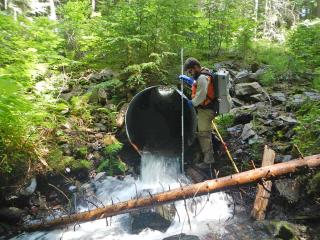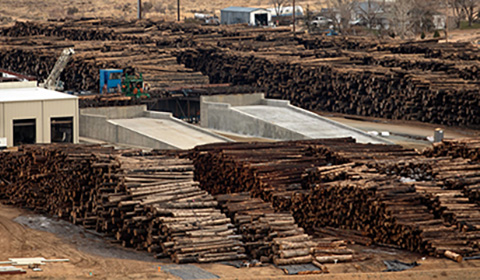
In August 2017, a wildfire swept through more than 24,000 acres of central Oregon, threatening the small town of Sisters at the foot of the Cascades Mountains. Residents in subdivisions near Sisters were severely threatened and had to evacuate to escape the flames.
As the fire grew closer to the subdivisions and the community of Sisters, the wildfire moved from travelling through the tops of trees to the ground. Getting the fire to the ground gave the firefighters the opportunity to safely take a direct attack on the blaze, which slowed the fire and saved homes.
That happened because the community in Sisters rallied around a project that worked to reduce vegetation that can fuel wildfires. That work also helped to improve the health of forests in Central Oregon’s fire-adapted ecosystem.
‘I was really proud of all the work that had been done. Our treatments functioned just as they were supposed to when the fire came through,” said Nicole Strong, Oregon State University Extension Forester and former outreach chair of the Deschutes Collaborative Forest Project. “The fire, once it entered the treated area, hit the ground and made it safe for firefighters to come and fight the fire lower its intensity. Because of the treatments, we were able to save the communities and the trees are still alive.”

Congress established the program to encourage local, state, tribal and national partnerships to leverage resources toward work that targets priority forest landscapes. The goal is to reduce the risks of uncharacteristic wildfires, improve ecological and watershed health, and support rural communities. Another goal is to use restoration by-products to off-set the cost of restoration and boost local economies. The small, woody by-products of restoration can be used for heat, erosion control and other such uses.
Resilient landscapes provide integral resources and services to ecosystems and communities. From water purification to recreational opportunities, to wildlife and plant diversity, to a sustainable supply of wood products, our nation relies on our forested land for ecological, social, and economic benefits. Restored landscapes are not only better able to sustain these benefits—the landscapes are also more resilient to stresses that range from invasive species infestations to drought.
Funding from the program may only be used on national forests or grasslands and proposals may be funded for no more than 10 years, although some may be extended for longer on a case-by-case basis. In 2020, a new program landscape was selected and funded for the first time since 2012 – the Northern Blues (PDF, 16.9 MB) landscape project in Oregon.

Since launching just over 10 years ago, the program created an average of $215 million in local labor income annually, and supported an average of 5,210 jobs every year. With the help from our local and national partners, many young people gain work experience while learning crucial skills in environmental stewardship. The work on the ground further benefits from thousands of hours of volunteer time from members of local communities.
But we still have a lot of work left to do, and we need your help. There are several ways to pitch in, including volunteering for forest restoration efforts, joining one of several conservation corps, or simply by helping to educate others about forest restoration efforts.
Related Content:
Collaborative Forest Landscape Restoration Program Overview
There’s more to restoration than planting trees





